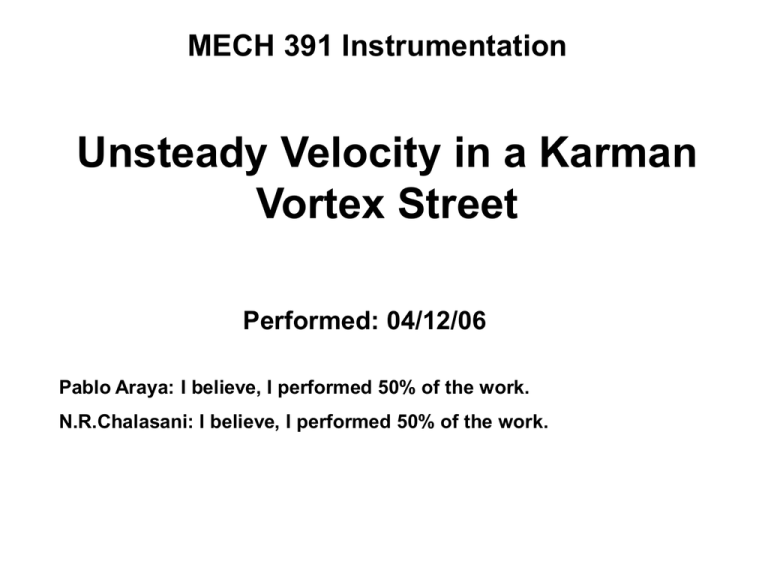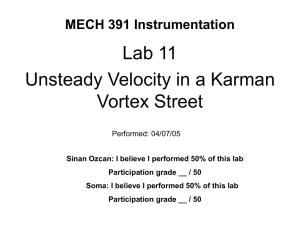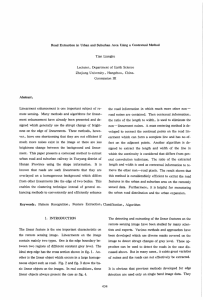
MECH 391 Instrumentation
Unsteady Velocity in a Karman
Vortex Street
Performed: 04/12/06
Pablo Araya: I believe, I performed 50% of the work.
N.R.Chalasani: I believe, I performed 50% of the work.
ABSTRACT
• The objective of this lab was to calibrate a hot
film anemometer using a Pitot probe and use it to
measure the unsteady speed in a Karman vortex
street.
• The dominant frequency in the unsteady wake
was measured for a range of wind speeds.
• The Stroughal number (dimensionless
frequency) was consistently one half the
predicted value for the full Reynolds number
range investigated.
Fig. 1 VI Front Panel
Fig. 2 VI Block Diagram
Convert from Dynamic Data
Convert from Dynamic Data
Converts the dynamic data type to numeric, Boolean, waveform, and array data types for
use with other VIs and functions.
Formula
Formula
Uses a calculator interface to create mathematical formulas. You can use this Express VI
to perform most math functions that a basic scientific calculator can compute.
-------------------This Express VI is configured as follows:
Formula: ((v**2-b)/a)**2
Spectral Measurements
Spectral Measurements
Performs spectral measurements, such as peak spectrum and auto-power spectrum, on
a signal.
-------------------This Express VI is configured as follows:
Selected Measurements: Magnitude (RMS)
View Phase: Wrapped and in Radians
Windowing: Hanning
Averaging: None
Convert from Dynamic Data2
Convert from Dynamic Data
Converts the dynamic data type to numeric, Boolean, waveform, and array data types for
use with other VIs and functions.
Table 1 Air Properties and Cylinder Diameter
T
°C
300
Patm
mbar
860
D
inch
0.125
m
N-s/m2
1.82E-05
• Air Viscosity from A.J. Wheeler and A. R. Ganji, Introduction to
Engineering Experimentation, 2nd Edition, Pearson Prentice
Hall, 2004, p. 430.
Table 2 Calibration Data
IG
IP
VCTA
PG
PP
PABS
mA
4.00
4.20
4.39
4.59
4.69
4.83
4.99
4.87
4.65
4.49
4.30
4.00
mA
4.00
5.93
7.98
10.01
11.17
12.35
14.02
12.72
10.42
8.91
6.95
4.00
volt
1.493
2.675
2.852
2.968
3.022
3.070
3.133
3.091
2.989
2.900
2.776
1.494
Pa
0
125
243
367
430
517
616
542
405
305
187
0
Pa
0
90
186
281
335
390
468
407
300
229
138
0
kPa
86.0
211.7
330.0
454.5
516.7
603.9
703.5
628.8
491.8
392.2
274.0
87.2
r
kg/m3
1.01
1.01
1.01
1.01
1.02
1.02
1.02
1.02
1.02
1.01
1.01
1.01
SA
m/s
0.00
13.35
19.15
23.52
25.68
27.69
30.32
28.30
24.30
21.26
16.49
0.00
• The initial and final no-wind hot film voltage readings
are close but not the same.
Figure 3 Hot Film System Calibration
12
3.5
VCTA2 = 1.366SA1/2 + 2.2057
3.0
2.5
VCTA [volt]
2
6
VCTA [volt ]
8
2
10
4
2.0
1.5
1.0
2
0.5
0
0.0
0
1
2
3
SA
0.5
4
0.5
[m/s]
5
6
0
10
20
30
SA [m/s]
• The fit equation VCTA2 = aSA0.5+b appears to be appropriate for these data.
• The dimensional parameters are a = 1.366 volts2s1/2/m1/2 and b = 2.2057
volts2
40
Fig. 4 Measured Speed vs. Time for Highest Wind
Speed
50
45
40
SA [m/s]
35
30
25
20
15
10
5
0
0.5000
0.5005
0.5010
0.5015
0.5020
0.5025
t [sec]
• 5 large peaks in 0.00025 seconds corresponds to frequency
1780 hz.
Fig. 5 Spectral Content in Wake for Highest Wind Speed
0.45
0.4
SA,RMS [m/s]
0.35
0.3
0.25
0.2
0.15
0.1
0.05
0
0
500
1000
1500
2000
2500
1500
2000
2500
f [hz]
0.25
SA,RMS [m/s]
0.2
0.15
0.1
0.05
0
0
500
1000
f [hz]
• Largest spectral content is at 1780 hz.
Table 3 Karmon Frequency and
Incoming Wind Speed
f
hz
1780
1340
1280
1060
1536
613
SA
m/s
31.06
24.2
22.06
18.33
26.66
11.4
Re
[1]
5473
4264
3887
3230
4697
2009
St
[1]
0.1820
0.1758
0.1842
0.1836
0.1829
0.1707
Fig. 4 Stroughal versus Reynolds
0.25
Reference Value St = 0.2 to 0.21
St [1]
0.20
0.15
0.10
0.05
0.00
0
1000
2000
3000
4000
5000
6000
Re [1]
• Measured Stroughal number is roughly 15% below the expected value.
• The reference value is from A.J. Wheeler and A.R. Ganji, Introduction to Engineering
Experimentation, 2nd Edition, Pearson Prentice Hall, 2004, p. 337
• Noise in the hot film signal may cause this difference.












